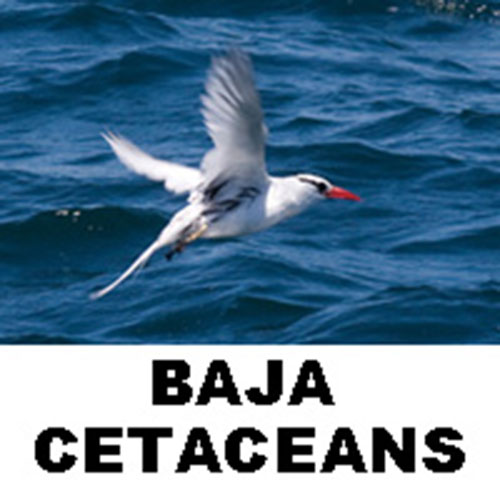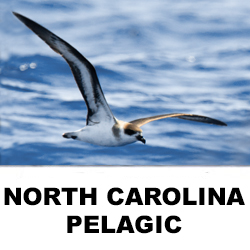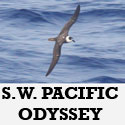|
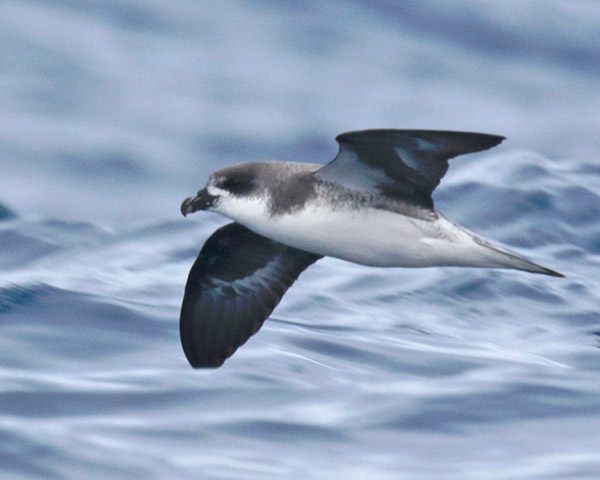 We have travelled to many places in search of seabirds, but one of the rarest Pterodromae has always been quite
close to home, some 60 pairs breeding on the island of Madeira. I refer of course to Zino’s Petrel. Also to be
seen in that part of the world are Fea’s Petrels and several other seabirds, making a visit at some stage
imperative for me. For many years the only way to see these birds was by much land-based seawatching,
and Zino’s and Fea’s were always thought to be inseparable, even if views were close, which is unlikely from a
headland. However since 2010 all that has changed. Thanks to pioneering work by Hadoram Shirihai as to the best
area to observe them (Zino’s), the publication of the excellent North Atlantic Petrels, by Bob Flood and
Ashley Fisher, and most importantly, a series of pelagic trips run by Windbirds, over three days, it is now
possible to visit the specific areas where the birds may be seen.
We have travelled to many places in search of seabirds, but one of the rarest Pterodromae has always been quite
close to home, some 60 pairs breeding on the island of Madeira. I refer of course to Zino’s Petrel. Also to be
seen in that part of the world are Fea’s Petrels and several other seabirds, making a visit at some stage
imperative for me. For many years the only way to see these birds was by much land-based seawatching,
and Zino’s and Fea’s were always thought to be inseparable, even if views were close, which is unlikely from a
headland. However since 2010 all that has changed. Thanks to pioneering work by Hadoram Shirihai as to the best
area to observe them (Zino’s), the publication of the excellent North Atlantic Petrels, by Bob Flood and
Ashley Fisher, and most importantly, a series of pelagic trips run by Windbirds, over three days, it is now
possible to visit the specific areas where the birds may be seen.
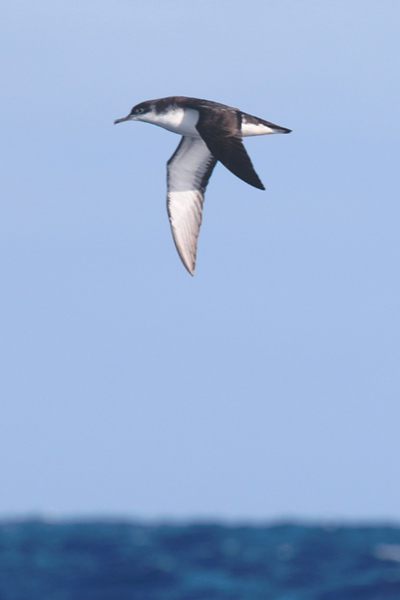 Ann can no longer do small-boat pelagic trips, so I found another masochist in the shape of Mike Sidwell, a
long-time birding friend of mine and excellent birder, and we booked a week in Madeira. The pelagic trips run
normally on Tuesday, Wednesday and Thursday afternoons, but the organisers recommend a week in case any day is
cancelled due to bad, or more likely, exceptionally good weather (i.e. no wind and flat calm seas). The full week
also enables you to “clean-up” on the few island specialities, two endemics, several endemic subspecies, and
three Macaronesian endemics (breeding on Madeira and the Canaries). This can be done in a day with a bit of
rushing about, but is far better taken at relaxed pace with some seawatching in the evenings, since one seabird
is rarely seen from the boat (although a recent trip did record two). This is the Little or Macaronesian
Shearwater Puffinus baroli. Although the exact taxonomic position of this bird is open to much debate, it is
the taxon which is seen in British waters, and which visited a Manx colony on Skomer for a couple of years.
I had never seen a Little Shearwater north of the equator, so going by current theories I hadn’t seen one at all,
but I was familiar with the flight action, which is certainly not “auk-like” as many field guides would have
you believe. Mike had seen them in the Canaries, so was equally well-equipped to find one on a seawatch.
Ann can no longer do small-boat pelagic trips, so I found another masochist in the shape of Mike Sidwell, a
long-time birding friend of mine and excellent birder, and we booked a week in Madeira. The pelagic trips run
normally on Tuesday, Wednesday and Thursday afternoons, but the organisers recommend a week in case any day is
cancelled due to bad, or more likely, exceptionally good weather (i.e. no wind and flat calm seas). The full week
also enables you to “clean-up” on the few island specialities, two endemics, several endemic subspecies, and
three Macaronesian endemics (breeding on Madeira and the Canaries). This can be done in a day with a bit of
rushing about, but is far better taken at relaxed pace with some seawatching in the evenings, since one seabird
is rarely seen from the boat (although a recent trip did record two). This is the Little or Macaronesian
Shearwater Puffinus baroli. Although the exact taxonomic position of this bird is open to much debate, it is
the taxon which is seen in British waters, and which visited a Manx colony on Skomer for a couple of years.
I had never seen a Little Shearwater north of the equator, so going by current theories I hadn’t seen one at all,
but I was familiar with the flight action, which is certainly not “auk-like” as many field guides would have
you believe. Mike had seen them in the Canaries, so was equally well-equipped to find one on a seawatch.
I digress, so back to the pelagic trips. We had read many trip reports which essentially indicated that an amount
of luck is required to see all the most-desired species. Timing seems not to be too important between April and
September, with two provisos. Several migrant species occur in May and the latter half of August and September,
these were of no real interest to us but do include Great Shearwater, plus the odd rarity such as a Tropicbird.
As this latter species is a real one-off, and not generally thought of as migratory, timing would not be an issue.
Too early in the season and it’s possible to miss Fea’s Petrel, as it breeds slightly later and not many birds will
have returned from non-breeding foraging areas. The other big “luck” factor is the weather. Thankfully Madeira
normally has a brisk prevailing wind from the North, which means there is usually a swell on the ocean, but on
calmer days seabirds tend to sit on the water, and don’t visit the chum slick to anything like the same degree.
So, as we left Gatwick, Mike was worrying about too calm a sea, I was worrying about being seasick! In the event
all our fears were unfounded, but I must stress that nothing is for certain on these pelagics. In a way that adds
to the enjoyment-who would ever go twitching if no-one ever dipped? We arrived just before lunch time on Sunday,
whilst I was sorting out the hire car Mike set up his telescope and almost immediately called a couple of Pterodromae!
Funchal airport is on the coast, the main runway built on stilts in the ocean, and so is actually a good seawatching
site. Not normally whilst sorting out the hire car though! The birds were too distant to be absolutely identified,
but certainly had a suitable flight action, and we later saw a Fea’s Petrel from the boat in that same area whilst
returning to harbour. The rest of the afternoon was spent booking in to our hotel, driving North to Ponta de Sao
Lourenco on an exploratory trip, and discovering that a Renault Twingo is totally unsuited to driving on Madeira.
The problem is that, apart from a few sections of dual-carriageway, roads on the island are either uphill, downhill,
round a tight bend, or two of these combined. The result of this is that you need a car with plenty of torque and
preferably power. The only attribute a Twingo boasts is a fantastic lock enabling parking in small spaces. So if you
visit Madeira as a birder, don’t go for the cheapest hire car. Having made our bed we had to lie in it, so spent much
time in first gear holding up the locals, although it did get easier as I became more familiar with the car and was
able to negotiate the bends a bit faster.
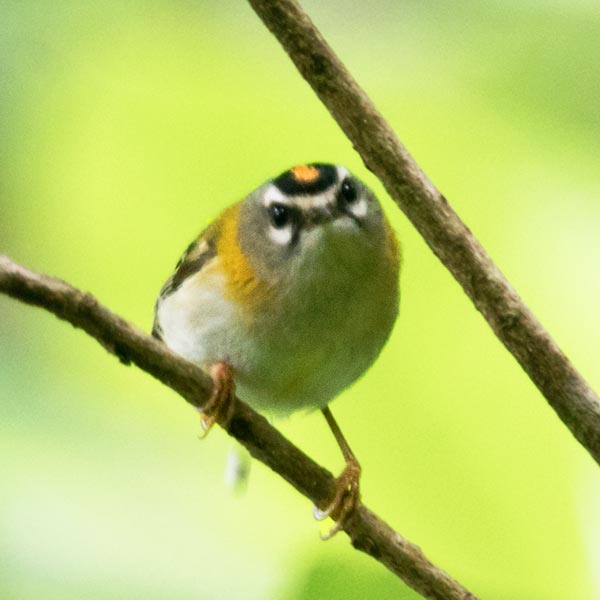 On that first afternoon we saw Rock Sparrow, which is restricted in Madeira to a few sites, and the Macronesian endemic
Berthelot’s Pipit. Our hotel was in Machico, from where the pelagic boat sets off, and we only drove a few miles north
to get an idea of the island. Day two was the almost obligatory visit to Ribeiro Frio and Faja da Nogueira. Trocaz
(or Madeiran Laurel) Pigeon seems to be easier than in some earlier reports, but you still need to be there fairly
early to see perched birds. Incidentally, later in the week driving back from Porto Moniz we saw several birds
perched on telephone wires in the evening, although they flew off if the car as much as slowed down, presumably a
leftover from days when they were heavily hunted. Other birds seen that day more or less completed the list of endemics
and endemic subspecies that look significantly different, including Madeiran Firecrest, Plain Swift, Atlantic Canary
and the very different looking Chaffinch, which appears in some numbers to be fed when a group of tourists arrives at
the Ribeiro Frio watchpoint. We returned via Funchal, looking for a good seawatching spot, but decided that it was far
too developed and of no real advantage, a quick visit to the harbour revealed a similar situation, certainly we saw no
Roseate Terns (I wonder if it is still the best site). There are probably some good sites near Funchal if you are based
there, as most holidaymakers are, but we found everything we wanted to see in the more rural areas.
On that first afternoon we saw Rock Sparrow, which is restricted in Madeira to a few sites, and the Macronesian endemic
Berthelot’s Pipit. Our hotel was in Machico, from where the pelagic boat sets off, and we only drove a few miles north
to get an idea of the island. Day two was the almost obligatory visit to Ribeiro Frio and Faja da Nogueira. Trocaz
(or Madeiran Laurel) Pigeon seems to be easier than in some earlier reports, but you still need to be there fairly
early to see perched birds. Incidentally, later in the week driving back from Porto Moniz we saw several birds
perched on telephone wires in the evening, although they flew off if the car as much as slowed down, presumably a
leftover from days when they were heavily hunted. Other birds seen that day more or less completed the list of endemics
and endemic subspecies that look significantly different, including Madeiran Firecrest, Plain Swift, Atlantic Canary
and the very different looking Chaffinch, which appears in some numbers to be fed when a group of tourists arrives at
the Ribeiro Frio watchpoint. We returned via Funchal, looking for a good seawatching spot, but decided that it was far
too developed and of no real advantage, a quick visit to the harbour revealed a similar situation, certainly we saw no
Roseate Terns (I wonder if it is still the best site). There are probably some good sites near Funchal if you are based
there, as most holidaymakers are, but we found everything we wanted to see in the more rural areas.
 Tuesday was our first day for a pelagic trip, and conditions seemed good. A few “white horses” out to sea, but not too
rough to stand up while drifting around the chum slick. In the morning we wandered up to Canical (15 minutes by car,
25 by Twingo) to see the local colony of Spanish Sparrows, which are uncommon elsewhere on the main island. Around the
harbour area were Whimbrel and Turnstone. We investigated a scrubby area nearby where we found breeding Spectacled Warblers,
then returned to Canichal and had a fairly substantial lunch. This is as advised by the organisers and I have to say seems
to help prevent seasickness. I have always had a problem on small boats, but never before tried the full stomach thing, I
can report that nobody on any of the three trips was seasick. With regard to warnings about salt water spray and keeping
cameras dry on the journeys out and back, it is possible to get absolutely drenched, so don’t take the warnings lightly.
Cameras should be kept readily available, since if anything interesting is sighted, they will slow, and if that sighting
is a Pterodroma it may well be on view for less than a minute. The boat is basically a rigid-hull inflatable, or Zodiac,
with about a dozen seats. Whilst such boats are extremely safe, don’t expect too comfortable a journey out and back. The
trips last seven hours, giving about three hours circling the chum slick, and the location will vary from day to day
dependent on sightings. First day is always (weather permitting) to the best area for Zino’s, since that is what most
people come to see. We set off on time from Machico harbour, all eager to see what the day would bring. In truth I think
most people were expecting to see one or two Fea’s Petrels and a Zino’s if we were lucky, it was the first day and
there were two more trips to come. Most groups of three trips score at least one Zino’s, although usually it is more.
To get one on the first day would take the pressure off, and it was in that frame of mind we left the harbour.
Tuesday was our first day for a pelagic trip, and conditions seemed good. A few “white horses” out to sea, but not too
rough to stand up while drifting around the chum slick. In the morning we wandered up to Canical (15 minutes by car,
25 by Twingo) to see the local colony of Spanish Sparrows, which are uncommon elsewhere on the main island. Around the
harbour area were Whimbrel and Turnstone. We investigated a scrubby area nearby where we found breeding Spectacled Warblers,
then returned to Canichal and had a fairly substantial lunch. This is as advised by the organisers and I have to say seems
to help prevent seasickness. I have always had a problem on small boats, but never before tried the full stomach thing, I
can report that nobody on any of the three trips was seasick. With regard to warnings about salt water spray and keeping
cameras dry on the journeys out and back, it is possible to get absolutely drenched, so don’t take the warnings lightly.
Cameras should be kept readily available, since if anything interesting is sighted, they will slow, and if that sighting
is a Pterodroma it may well be on view for less than a minute. The boat is basically a rigid-hull inflatable, or Zodiac,
with about a dozen seats. Whilst such boats are extremely safe, don’t expect too comfortable a journey out and back. The
trips last seven hours, giving about three hours circling the chum slick, and the location will vary from day to day
dependent on sightings. First day is always (weather permitting) to the best area for Zino’s, since that is what most
people come to see. We set off on time from Machico harbour, all eager to see what the day would bring. In truth I think
most people were expecting to see one or two Fea’s Petrels and a Zino’s if we were lucky, it was the first day and
there were two more trips to come. Most groups of three trips score at least one Zino’s, although usually it is more.
To get one on the first day would take the pressure off, and it was in that frame of mind we left the harbour.

 We started to see Cory’s Shearwaters almost immediately, including a small group on the water. This was no great surprise as large
numbers breed in the area and flocks can be seen from land most of the time. We stayed not far offshore until we reached
the North-eastern tip of the island, when we made our way through a narrow channel between the mainland and an islet,
and into the predominant Northerly wind and accompanying waves! We then proceeded, crashing over the sea as only a Zodiac
can, to a spot about 12km north of the main island, where our chumming session commenced. However, as often happens, we
had several sightings before reaching the “hot-spot”, which rather changed the mood on the boat. Our first sighting of
interest was a Bryde’s Whale, the more common whale in the area, although few people saw much more than a blow and a
small area of the grey back; we were then followed by a school of Bottlenose Dolphins for a while just before reaching
the channel, but suddenly all cetacean interest was stopped by a cry of “Pterodroma!” At this stage everyone was ecstatic
just to see one, whether Fea’s or Zino’s, the bird passed by at some range but enough for everyone to get a decent view
in their binoculars. Experience, in the form of Catarina and Hugo, owners of Windbirds, determined it was a Fea’s.
A great start to the trip, but we had only just cleared the North-east tip and were getting used to crashing over the
wave tops, when another was sighted. This looked good! The boat slowed and we all got more practice at finding the bird
and keeping it in our binoculars whilst the swell moved us up and down. In reality it’s not too difficult, a bit harder
trying to take photos though, I had lots of shots of empty sea! The boat had hardly got going again, and cameras returned
to dry bags, when Hugo shouted “Zino’s Petrel”. My immediate thought was that we had all spent much time studying books
and videos in order to distinguish the two taxa, could anyone be that confident? A few seconds later I realised it was
possible, as a classic Zino’s Petrel flew round the boat, passing about six feet behind it. When you see a bird showing
all the possible identification features that close you realise there is no question- you have just seen one of the world’s
rarest seabirds. Although there is much overlap, this one was Zino’s without a doubt, from the small bill (we could even
see the depth of the mandibles with the naked eye) through the large amount of white in the underwing, to the slender jizz.
Someone said “right, we can go home now”, but it was a joke, we all wanted more, and strangely hadn’t even seen a Bulwer’s
Petrel yet. These birds, breeding locally in large numbers, can normally be seen from shore, but for some reason weren’t
much in evidence. No problem though, a few kilometres and a couple of Pterodromas later they began to appear, and remained
on show most of the rest of the day. About twenty minutes later we reached the designated area and put out the chum, a
solid mass designed to release food (and odours) over a period, whilst the boat circled the resultant oily slick.
We started to see Cory’s Shearwaters almost immediately, including a small group on the water. This was no great surprise as large
numbers breed in the area and flocks can be seen from land most of the time. We stayed not far offshore until we reached
the North-eastern tip of the island, when we made our way through a narrow channel between the mainland and an islet,
and into the predominant Northerly wind and accompanying waves! We then proceeded, crashing over the sea as only a Zodiac
can, to a spot about 12km north of the main island, where our chumming session commenced. However, as often happens, we
had several sightings before reaching the “hot-spot”, which rather changed the mood on the boat. Our first sighting of
interest was a Bryde’s Whale, the more common whale in the area, although few people saw much more than a blow and a
small area of the grey back; we were then followed by a school of Bottlenose Dolphins for a while just before reaching
the channel, but suddenly all cetacean interest was stopped by a cry of “Pterodroma!” At this stage everyone was ecstatic
just to see one, whether Fea’s or Zino’s, the bird passed by at some range but enough for everyone to get a decent view
in their binoculars. Experience, in the form of Catarina and Hugo, owners of Windbirds, determined it was a Fea’s.
A great start to the trip, but we had only just cleared the North-east tip and were getting used to crashing over the
wave tops, when another was sighted. This looked good! The boat slowed and we all got more practice at finding the bird
and keeping it in our binoculars whilst the swell moved us up and down. In reality it’s not too difficult, a bit harder
trying to take photos though, I had lots of shots of empty sea! The boat had hardly got going again, and cameras returned
to dry bags, when Hugo shouted “Zino’s Petrel”. My immediate thought was that we had all spent much time studying books
and videos in order to distinguish the two taxa, could anyone be that confident? A few seconds later I realised it was
possible, as a classic Zino’s Petrel flew round the boat, passing about six feet behind it. When you see a bird showing
all the possible identification features that close you realise there is no question- you have just seen one of the world’s
rarest seabirds. Although there is much overlap, this one was Zino’s without a doubt, from the small bill (we could even
see the depth of the mandibles with the naked eye) through the large amount of white in the underwing, to the slender jizz.
Someone said “right, we can go home now”, but it was a joke, we all wanted more, and strangely hadn’t even seen a Bulwer’s
Petrel yet. These birds, breeding locally in large numbers, can normally be seen from shore, but for some reason weren’t
much in evidence. No problem though, a few kilometres and a couple of Pterodromas later they began to appear, and remained
on show most of the rest of the day. About twenty minutes later we reached the designated area and put out the chum, a
solid mass designed to release food (and odours) over a period, whilst the boat circled the resultant oily slick.
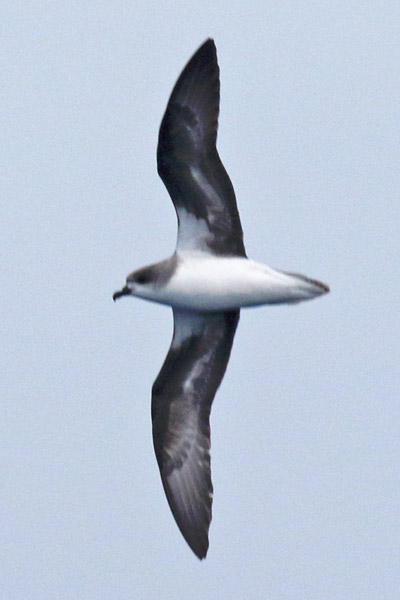
 It’s all become a bit of a blur now, but I know I wasn’t dreaming as I’ve got hundreds of images. Our luck continued in the
same vein, more Fea’s Petrels and at least another five Zino’s approached our chum and (usually) circled the boat. We
found that the Zino’s would circle once or twice, whereas Fea’s would often just pass by quite quickly. Nevertheless it
was far more than we had dared to hope, prompting a tongue-in-cheek Hugo to apologise for the large number of Pterodromas,
since up to five or six was the norm, and he thought we might be getting bored with them! We even saw, albeit distantly,
a small flock of Fea’s Petrels moving in one direction. Whether we had hit on a passage movement, since birds are known
to disperse in winter, or more likely there was food in the area to which they were heading.
We will never know the reasons, but eventually the sightings began to lessen in number and just before we were due to head back
Mike said “what’s gone wrong, we haven’t seen a Pterodroma for nearly an hour”. The Madeiran and Wilson’s Storm-petrels
which visited the slick after we’d been drifting a while were just the icing on a very large cake. We knew we’d experienced
one of the most memorable days of our lives, possibly never to be bettered in terms of numbers of sightings.
A few more birds were seen on the return journey, including Manx Shearwaters and more petrels, and most agreed that our
“tally” for the afternoon was between twenty and thirty Fea’s Petrels and six to eight Zino’s. Of course this will be
inaccurate, since some birds may have visited us twice, plus others weren’t clearly one species or the other, but it does
indicate the unprecedented nature of Tuesday’s pelagic, and two days still to come!
(The Windbirds website states eleven Zino's and twenty-four Fea's on the Tuesday, but I suspect that we didn't
include several distant birds which wouldn't have been identifiable to species, and some of the Zino's were too distant for our
less experienced eyes to be certain). Looking back over past trip reports
it does seem that Pterodroma Tuesday, as we have dubbed it, was the most successful one day trip ever in these waters,
certainly in terms of numbers of pterodromas seen.
It’s all become a bit of a blur now, but I know I wasn’t dreaming as I’ve got hundreds of images. Our luck continued in the
same vein, more Fea’s Petrels and at least another five Zino’s approached our chum and (usually) circled the boat. We
found that the Zino’s would circle once or twice, whereas Fea’s would often just pass by quite quickly. Nevertheless it
was far more than we had dared to hope, prompting a tongue-in-cheek Hugo to apologise for the large number of Pterodromas,
since up to five or six was the norm, and he thought we might be getting bored with them! We even saw, albeit distantly,
a small flock of Fea’s Petrels moving in one direction. Whether we had hit on a passage movement, since birds are known
to disperse in winter, or more likely there was food in the area to which they were heading.
We will never know the reasons, but eventually the sightings began to lessen in number and just before we were due to head back
Mike said “what’s gone wrong, we haven’t seen a Pterodroma for nearly an hour”. The Madeiran and Wilson’s Storm-petrels
which visited the slick after we’d been drifting a while were just the icing on a very large cake. We knew we’d experienced
one of the most memorable days of our lives, possibly never to be bettered in terms of numbers of sightings.
A few more birds were seen on the return journey, including Manx Shearwaters and more petrels, and most agreed that our
“tally” for the afternoon was between twenty and thirty Fea’s Petrels and six to eight Zino’s. Of course this will be
inaccurate, since some birds may have visited us twice, plus others weren’t clearly one species or the other, but it does
indicate the unprecedented nature of Tuesday’s pelagic, and two days still to come!
(The Windbirds website states eleven Zino's and twenty-four Fea's on the Tuesday, but I suspect that we didn't
include several distant birds which wouldn't have been identifiable to species, and some of the Zino's were too distant for our
less experienced eyes to be certain). Looking back over past trip reports
it does seem that Pterodroma Tuesday, as we have dubbed it, was the most successful one day trip ever in these waters,
certainly in terms of numbers of pterodromas seen.
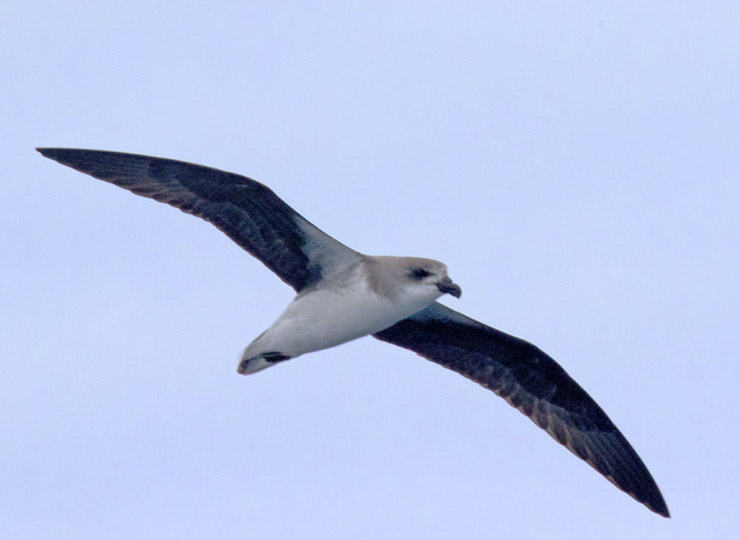
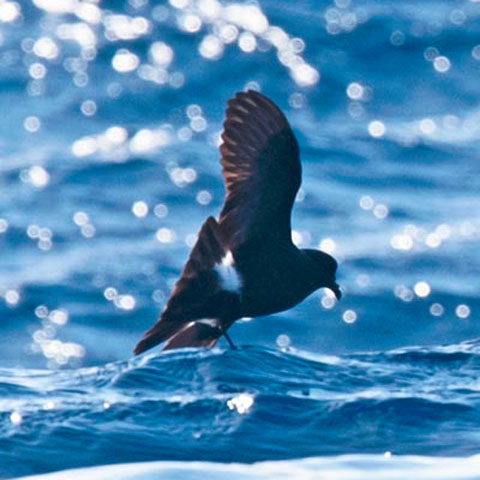
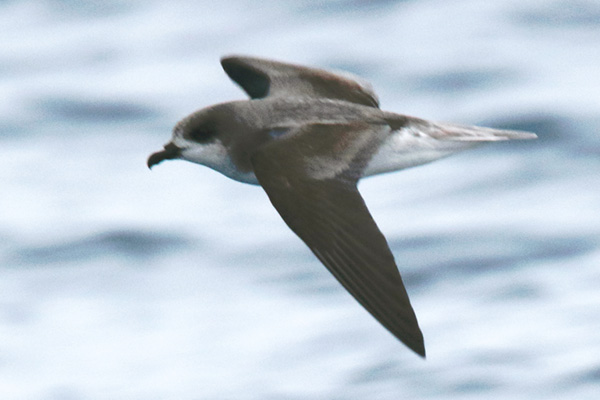 These trips can be pretty tiring, partly because of the extended adrenaline rush, so we had a bit of a lie-in on Wednesday.
We had a walk alongside the stream which enters the sea here and saw introduced Waxbills, obliging Blackcaps (race heineken)
and Monarch and Clouded Yellow butterflies. Then a leisurely lunch and it was off to the harbour for day two of our pelagic
adventure. Today the boat travelled to the south in search of storm-petrels, as years of experience has meant that Hugo and Catarina
know the best areas for specific species. The prevailing wind is from the north, so we set out
in sunny conditions with a much calmer sea, the wind being behind us, but were warned to expect rough conditions on
the way back. We were expecting an anti-climax after the previous day, but we still enjoyed an excellent pelagic. Two or
three Fea’s Petrels were seen on the way out, along with the usual suspects in the forms of Cory’s Shearwaters and Bulwer’s
Petrels. When we reached the chumming area things were quieter, the first birds to visit the chum were
Yellow-legged Gulls, common enough around Madeira’s harbours. Over the course of the next three hours we saw another
Fea’s Petrel, which approached closely, large numbers of Bulwer’s Petrels, and several Madeiran and Wilson’s Storm-petrels. The
Madeiran (or Band-rumped) in particular, gave excellent views, although none seemed to stay too long, up to nine were around
the chum at one point. Bulwer’s Petrels were almost constantly on show, and Cory’s every so often, both species investigating the
chum slick and so approaching the boat quite closely.
.
These trips can be pretty tiring, partly because of the extended adrenaline rush, so we had a bit of a lie-in on Wednesday.
We had a walk alongside the stream which enters the sea here and saw introduced Waxbills, obliging Blackcaps (race heineken)
and Monarch and Clouded Yellow butterflies. Then a leisurely lunch and it was off to the harbour for day two of our pelagic
adventure. Today the boat travelled to the south in search of storm-petrels, as years of experience has meant that Hugo and Catarina
know the best areas for specific species. The prevailing wind is from the north, so we set out
in sunny conditions with a much calmer sea, the wind being behind us, but were warned to expect rough conditions on
the way back. We were expecting an anti-climax after the previous day, but we still enjoyed an excellent pelagic. Two or
three Fea’s Petrels were seen on the way out, along with the usual suspects in the forms of Cory’s Shearwaters and Bulwer’s
Petrels. When we reached the chumming area things were quieter, the first birds to visit the chum were
Yellow-legged Gulls, common enough around Madeira’s harbours. Over the course of the next three hours we saw another
Fea’s Petrel, which approached closely, large numbers of Bulwer’s Petrels, and several Madeiran and Wilson’s Storm-petrels. The
Madeiran (or Band-rumped) in particular, gave excellent views, although none seemed to stay too long, up to nine were around
the chum at one point. Bulwer’s Petrels were almost constantly on show, and Cory’s every so often, both species investigating the
chum slick and so approaching the boat quite closely.
.
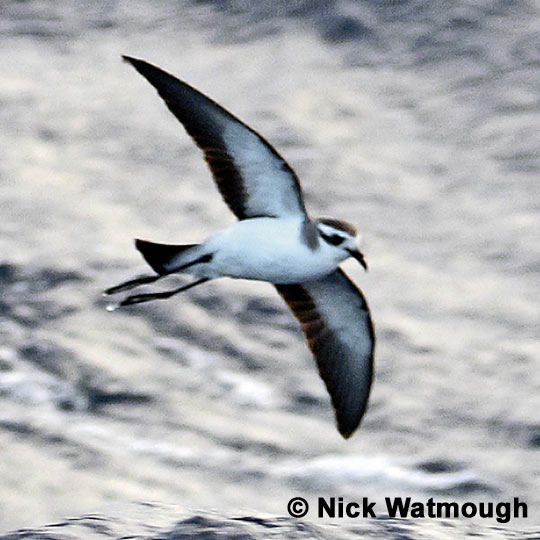
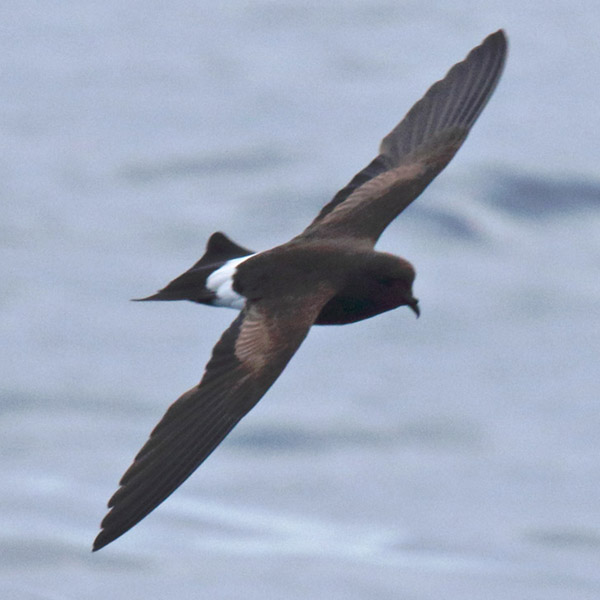 However, the one species everyone wanted to see to complete the list of "target species" had thus far
eluded us, that being White-faced Storm-petrel. On Tuesday several people had wondered why Catarina and Hugh stayed out so
late, when we had enjoyed such a fantastic day and were eager to get back and celebrate. On Wednesday we found out. It was
past eight pm and we were all awaiting a rough trip back and wanting to get it over with, but the boat kept circling the chum.
I had unfortunately put my camera away in preparation for getting soaked, when Catarina suddenly called “White-faced coming
in from the bow end!” It showed briefly, but enough for all to see it at least, and disappeared behind us. Not content with
this Hugh swung the boat round yet again, passed the chum and drifted back. No further sign, so he repeated the exercise.
As we proceeded back past the chum another was seen, and quickly changing direction once more revealed a third bird. It was
all a bit chaotic, but everyone got to see the classic features of this superb Stormie, the ridiculously long legs, springing
off the water like some jack-in-the-box, a different direction each time, and the very different plumage, the only Atlantic
Storm-petrel that isn’t predominantly dark overall. Nick managed to get an acceptable photo, I contented myself with watching
as I wouldn’t have got the camera out again in time. I think Hugo even had one further look around the chum before we headed
into the wind and back towards Machical. We didn’t care about the rough conditions, although it did get a bit hairy at times,
we didn’t care about getting soaked by large waves on a regular basis, we even slowed for (yet) another Fea’s Petrel on the
return journey, but we had seen all our target species after two days. Arriving back after dark Mike and I went straight to
a local bar to celebrate!
However, the one species everyone wanted to see to complete the list of "target species" had thus far
eluded us, that being White-faced Storm-petrel. On Tuesday several people had wondered why Catarina and Hugh stayed out so
late, when we had enjoyed such a fantastic day and were eager to get back and celebrate. On Wednesday we found out. It was
past eight pm and we were all awaiting a rough trip back and wanting to get it over with, but the boat kept circling the chum.
I had unfortunately put my camera away in preparation for getting soaked, when Catarina suddenly called “White-faced coming
in from the bow end!” It showed briefly, but enough for all to see it at least, and disappeared behind us. Not content with
this Hugh swung the boat round yet again, passed the chum and drifted back. No further sign, so he repeated the exercise.
As we proceeded back past the chum another was seen, and quickly changing direction once more revealed a third bird. It was
all a bit chaotic, but everyone got to see the classic features of this superb Stormie, the ridiculously long legs, springing
off the water like some jack-in-the-box, a different direction each time, and the very different plumage, the only Atlantic
Storm-petrel that isn’t predominantly dark overall. Nick managed to get an acceptable photo, I contented myself with watching
as I wouldn’t have got the camera out again in time. I think Hugo even had one further look around the chum before we headed
into the wind and back towards Machical. We didn’t care about the rough conditions, although it did get a bit hairy at times,
we didn’t care about getting soaked by large waves on a regular basis, we even slowed for (yet) another Fea’s Petrel on the
return journey, but we had seen all our target species after two days. Arriving back after dark Mike and I went straight to
a local bar to celebrate!
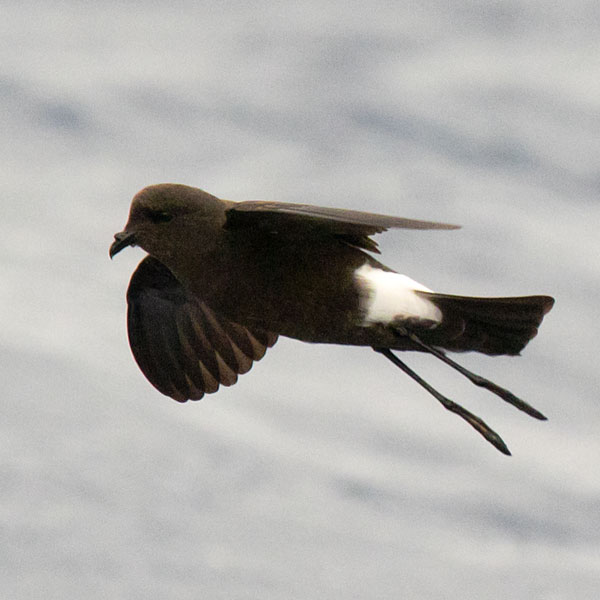 On Thursday we still had one more trip to do, the pressure was off, the weather much sunnier, and although the prevailing
northerly wind was still blowing the sea was calmer. Catarina and Hugo went back to the original spot that proved so
fantastic on Tuesday. Whether it was the calmer water (we did see flocks of Cory’s Shearwaters “rafting” on the way out)
or perhaps Tuesday’s numbers were part of a movement, but we saw far fewer Fea’s and Zino’s Petrels. This level of
sightings is of course the status quo, Tuesday had been phenomenal. Pods of Atlantic Spotted Dolphins surrounded the
boat on the way out and back, and we saw several Leatherback Turtles, one of which, a small juvenile, Hugo caught in a
net to remove a piece of discarded fishing line. We also came across a Sperm Whale loafing on the surface, this being
something I’ve not seen before, although I have seen them diving. So in its own way Thursday was just as enjoyable as the other days,
just a bit less of an adrenaline rush. Others birds included a Bonxie (or Brown Skua-why not?) unfortunately not close,
more stormies (mainly Wilson’s), Manx Shearwater and the usual Cory’s Shearwaters and Bulwer’s Petrels.
On Thursday we still had one more trip to do, the pressure was off, the weather much sunnier, and although the prevailing
northerly wind was still blowing the sea was calmer. Catarina and Hugo went back to the original spot that proved so
fantastic on Tuesday. Whether it was the calmer water (we did see flocks of Cory’s Shearwaters “rafting” on the way out)
or perhaps Tuesday’s numbers were part of a movement, but we saw far fewer Fea’s and Zino’s Petrels. This level of
sightings is of course the status quo, Tuesday had been phenomenal. Pods of Atlantic Spotted Dolphins surrounded the
boat on the way out and back, and we saw several Leatherback Turtles, one of which, a small juvenile, Hugo caught in a
net to remove a piece of discarded fishing line. We also came across a Sperm Whale loafing on the surface, this being
something I’ve not seen before, although I have seen them diving. So in its own way Thursday was just as enjoyable as the other days,
just a bit less of an adrenaline rush. Others birds included a Bonxie (or Brown Skua-why not?) unfortunately not close,
more stormies (mainly Wilson’s), Manx Shearwater and the usual Cory’s Shearwaters and Bulwer’s Petrels.
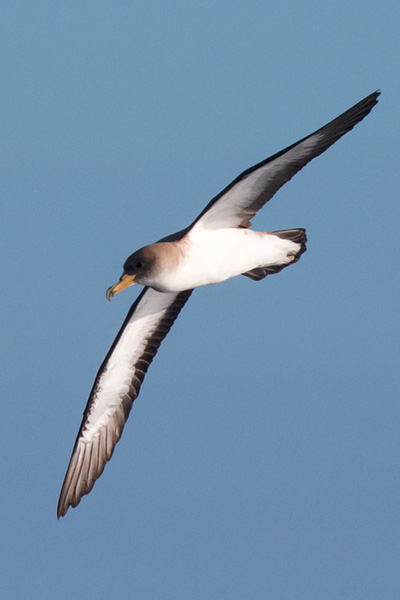 However, there was a sting in the tail.
There is always a point when things go quiet, we were sitting in the sunshine watching and photographing Bulwer’s
Petrels which invariably come close to the boat, when a Cory’s Shearwater appeared. I thought I’d take a few shots
as I’d been concentrating on other species and wasn’t sure I’d got a really good shot, despite the large numbers.
I got some upperwing shots as the bird circled behind, but it came back and banked in the opposite direction, thus
revealing its underwing. As I fired the shutter something seemed unusual, although I didn’t really register what it
was. I don’t normally rush to the back of the camera to see results as, especially with seabirds, you can’t do much
about it once the bird’s gone past. However on this occasion, a little voice said look- now! I blew up one of the
shots until just the primaries were in the frame-white inner webs-a Scopoli’s Shearwater! I showed the back of the
camera to Mike, who after wondering briefly why I was showing him a shot of a wingtip, got the idea and passed the
camera to John, who being involved with pelagic trips from Capetown, has far more experience of this taxon. John
readily agreed with our identification and the camera was passed back to Catarina and Hugo, who constitute two thirds
of Madeira’s rarities committee. No hesitation, the third record for the islands. Of course, they are probably a frequent
visitor, but with so many Cory’s in the area are easily overlooked, perhaps if the split is more widely accepted birders
will look more. The great thing about this sighting was that everyone on the boat was able to remember the bird, as it had
circled us only a minute or so previously, so we had our icing on a magnificent cake. Another Zino’s came for a quick look,
just to remind us of the purpose of the trip for most people, my last recollection was the Wilson’s Petrel which entertained
us by feeding for a considerable time close to the boat, I finally photographed the yellow webs to the feet. Oh, and the
Atlantic Spotted Dolphins on the way back, as if escorting the boat on a victory parade. And the last, brief Fea’s Petrel.
Beat that for a set of three trips!
However, there was a sting in the tail.
There is always a point when things go quiet, we were sitting in the sunshine watching and photographing Bulwer’s
Petrels which invariably come close to the boat, when a Cory’s Shearwater appeared. I thought I’d take a few shots
as I’d been concentrating on other species and wasn’t sure I’d got a really good shot, despite the large numbers.
I got some upperwing shots as the bird circled behind, but it came back and banked in the opposite direction, thus
revealing its underwing. As I fired the shutter something seemed unusual, although I didn’t really register what it
was. I don’t normally rush to the back of the camera to see results as, especially with seabirds, you can’t do much
about it once the bird’s gone past. However on this occasion, a little voice said look- now! I blew up one of the
shots until just the primaries were in the frame-white inner webs-a Scopoli’s Shearwater! I showed the back of the
camera to Mike, who after wondering briefly why I was showing him a shot of a wingtip, got the idea and passed the
camera to John, who being involved with pelagic trips from Capetown, has far more experience of this taxon. John
readily agreed with our identification and the camera was passed back to Catarina and Hugo, who constitute two thirds
of Madeira’s rarities committee. No hesitation, the third record for the islands. Of course, they are probably a frequent
visitor, but with so many Cory’s in the area are easily overlooked, perhaps if the split is more widely accepted birders
will look more. The great thing about this sighting was that everyone on the boat was able to remember the bird, as it had
circled us only a minute or so previously, so we had our icing on a magnificent cake. Another Zino’s came for a quick look,
just to remind us of the purpose of the trip for most people, my last recollection was the Wilson’s Petrel which entertained
us by feeding for a considerable time close to the boat, I finally photographed the yellow webs to the feet. Oh, and the
Atlantic Spotted Dolphins on the way back, as if escorting the boat on a victory parade. And the last, brief Fea’s Petrel.
Beat that for a set of three trips!
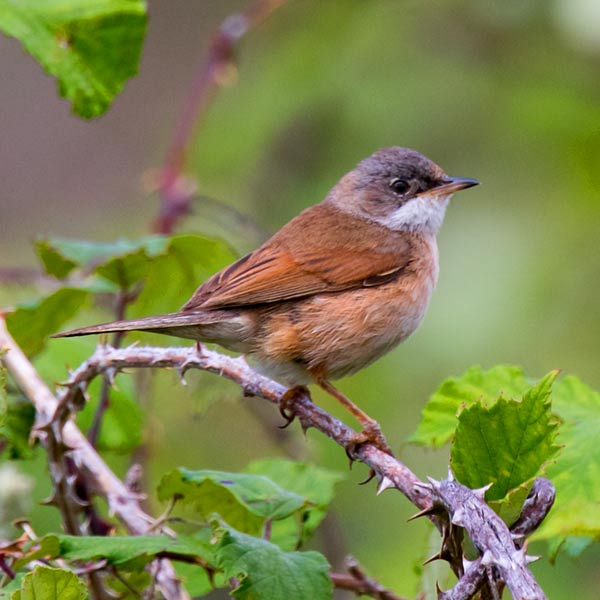 Coming down to earth the next morning, we still had two days on Madeira, with just a little unfinished business in the
shape of Macaronesian Shearwater. Our first attempt was in the west of the island, we decided to visit the Ponta do
Pargo area first, then travel north to spend the evening seawatching at Porto Moniz, the northwest tip, which is
considered to be one of the best spots for that activity. Ponta do Pargo has probably turned up most of Madeira’s
rarities, but on the first day of July we weren’t expecting much. We spent time investigating the uncultivated headland
and adding a few species to the list. Spectacled Warbler was much less obliging than the Canical birds, but Berthelot’s
Pipits but on a good display, enabling much better photos than the record shots of Sunday afternoon. When we started to
get excited about Linnet and Red-legged Partridge we decided it was time to give up, so we went to look over the sea at
the car park, although it’s really too high and it was mid-afternoon. This proved to be the case, but flocks of Plain
Swifts were circling, and we saw a bird which we thought may have been a Pallid Swift. It was never proven, but as we
looked through the flock, Mike suddenly called “Alpine Swift!” As this is a Madeiran rarity I straight away fired off
a few shots, although distant it is identifiable, but it didn’t stop for further investigation. Whilst continuing to
look we found our second rarity in a few minutes, a Barn Swallow. I use the term rarity, but there are so few birders
on Madeira nobody really knows, likewise there are undoubtedly many birds missed during migration. Suffice to say
they were both species we weren’t expecting, and we proceeded to Porto Moniz feeling that our incredible luck was continuing.
On arrival we found a suitable spot a few yards from where we ate, complete with seats if required! Our luck did continue,
and we saw at least one definite Barolo’s Shearwater, and possibly two others, all quite distant. Indeed the two possibles
were distant enough to have been Manx, so we left with a tick (for me), but not really any sense of satisfaction. This was
tempered by the sighting of three Bryde’s Whales, which gave good views. On our return to Machico we had about an hour of
daylight and did a bit more seawatching, in truth we saw as many birds as we had at the “hotspot”, although nothing out of
the ordinary. Our last day was the eventual anticlimax, although we did an evening seawatch almost in sight of our hotel, encouraged
by the previous day. This resulted in another Macaronesian Shearwater, sadly still quite distant. The day had been spent
in the laurel forests again, where Madeiran Firecrests were a bit more obliging, but quite honestly we couldn’t have cared
less. We’d seen everything we wanted and then some, I don’t think we’ll ever do a better pelagic, but we’re going to try!
Coming down to earth the next morning, we still had two days on Madeira, with just a little unfinished business in the
shape of Macaronesian Shearwater. Our first attempt was in the west of the island, we decided to visit the Ponta do
Pargo area first, then travel north to spend the evening seawatching at Porto Moniz, the northwest tip, which is
considered to be one of the best spots for that activity. Ponta do Pargo has probably turned up most of Madeira’s
rarities, but on the first day of July we weren’t expecting much. We spent time investigating the uncultivated headland
and adding a few species to the list. Spectacled Warbler was much less obliging than the Canical birds, but Berthelot’s
Pipits but on a good display, enabling much better photos than the record shots of Sunday afternoon. When we started to
get excited about Linnet and Red-legged Partridge we decided it was time to give up, so we went to look over the sea at
the car park, although it’s really too high and it was mid-afternoon. This proved to be the case, but flocks of Plain
Swifts were circling, and we saw a bird which we thought may have been a Pallid Swift. It was never proven, but as we
looked through the flock, Mike suddenly called “Alpine Swift!” As this is a Madeiran rarity I straight away fired off
a few shots, although distant it is identifiable, but it didn’t stop for further investigation. Whilst continuing to
look we found our second rarity in a few minutes, a Barn Swallow. I use the term rarity, but there are so few birders
on Madeira nobody really knows, likewise there are undoubtedly many birds missed during migration. Suffice to say
they were both species we weren’t expecting, and we proceeded to Porto Moniz feeling that our incredible luck was continuing.
On arrival we found a suitable spot a few yards from where we ate, complete with seats if required! Our luck did continue,
and we saw at least one definite Barolo’s Shearwater, and possibly two others, all quite distant. Indeed the two possibles
were distant enough to have been Manx, so we left with a tick (for me), but not really any sense of satisfaction. This was
tempered by the sighting of three Bryde’s Whales, which gave good views. On our return to Machico we had about an hour of
daylight and did a bit more seawatching, in truth we saw as many birds as we had at the “hotspot”, although nothing out of
the ordinary. Our last day was the eventual anticlimax, although we did an evening seawatch almost in sight of our hotel, encouraged
by the previous day. This resulted in another Macaronesian Shearwater, sadly still quite distant. The day had been spent
in the laurel forests again, where Madeiran Firecrests were a bit more obliging, but quite honestly we couldn’t have cared
less. We’d seen everything we wanted and then some, I don’t think we’ll ever do a better pelagic, but we’re going to try!
|











